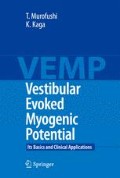Abstract
Vestibular evoked myogenic potential (VEMP) recording is a new tool for exploring the pathways of the sacculus, inferior vestibular nerve, vestibular nucleus, and sternocleidomastoid muscles (SCMs) in pediatric otology and neurotology.
Access this chapter
Tax calculation will be finalised at checkout
Purchases are for personal use only
Preview
Unable to display preview. Download preview PDF.
References
Sheykholeslami K, Kaga K, Megerin CA, et al (2005) Vestibular-evoked myogenic potentials in infancy and early childhood. Laryngoscope 115:1440–1444
Kaga K (2005) Development of balance and motor function achieved by central vestibular compensation. Adv Neurol Sci 49:216–228
Colebatch JG, Halmagyi GM, Skuse NF (1994) Myogenic potentials generated by a click-evoked vestibulocollic reflex. J Neurol Neurosurg Psychiatry 57:190–197
Sheykholeslami K, Kaga K (2002) The otolithic organ as a receptor of vestibular hearing revealed by vestibular-evoked myogenic potentials in patients with inner ear anomalies. Hear Res 165:62–67
Sheykholeslami K, Habiby Kermany M, Kaga K (2001) Frequency sensitivity range of the saccule to bone-conducted stimuli measured by vestibular evoked myogenic potentials. Hear Res 160:58–62
Watson SRD, Colebatch JG (1998) Vestibulocollic reflexes evoked by short-duration galvanic stimulation in man. J Physiol 513:587–597
Sheykholeslami K, Habiby Kermany M, Kaga K (2001) Bone-conducted vestibular evoked myogenic potentials in patients with congenital atresia of the external auditory canal. Int J Pediatr Otorhinolaryngol 57:25–29
Shinjo Y, Jin Y, Kaga K (2007) Assessment of vestibular function of infants and children with congenital and acquired deafness using the ice-water caloric test, rotational chair test and vestibular-evoked myogenic potential recording. Acta Otolaryngol (Stockh) 127:736–747
Sheykholeslami K, Schmerber S, Habiby Kermany M, et al (2004) Vestibular-evoked myogenic potentials in three patients with large vestibular aqueduct. Hear Res 190:161–168
Tien HC, Linthicum FH Jr (2002) Histopathologic changes in the vestibular after cochlear implantation. Otolaryngol Head Neck Surg 127:260–264
Jin Y, Nakamura M, Shinjo Y, et al (2006) Vestibular-evoked myogenic potentials in cochlear implant children. Acta Otolaryngol (Stockh) 126:164–169
Jin Y, Shinjo Y, Akamatsu Y, et al (2008) Vestibular evoked myogenic potentials evoked by multichannel cochlear implant-influence of C levels. Acta Otolaryngol (Stockh) 128:284–290
Kaga K, Tamai F, Kodama M, et al (2005) Three young adult patients with Pelizaeus-Merzbacher disease who showed only waves I and II in auditory brainstem responses but had good auditory perception. Acta Otolaryngol (Stockh) 125:1018–1023
Rights and permissions
Copyright information
© 2009 Springer
About this chapter
Cite this chapter
(2009). Neurootological Application of VEMP Recording During Infancy and Childhood. In: Vestibular Evoked Myogenic Potential. Springer, Tokyo. https://doi.org/10.1007/978-4-431-85908-6_12
Download citation
DOI: https://doi.org/10.1007/978-4-431-85908-6_12
Publisher Name: Springer, Tokyo
Print ISBN: 978-4-431-85907-9
Online ISBN: 978-4-431-85908-6
eBook Packages: MedicineMedicine (R0)

